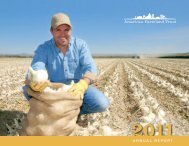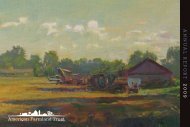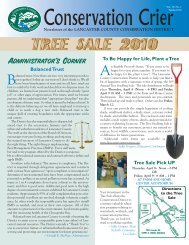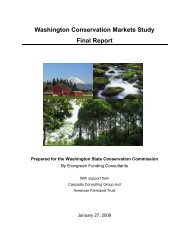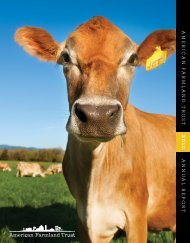Farms for the Future: Massachusetts - American Farmland Trust
Farms for the Future: Massachusetts - American Farmland Trust
Farms for the Future: Massachusetts - American Farmland Trust
You also want an ePaper? Increase the reach of your titles
YUMPU automatically turns print PDFs into web optimized ePapers that Google loves.
<strong>Massachusetts</strong>’ Investments in <strong>Farmland</strong> Conservation…Keeping <strong>Farms</strong> ProfitableIn 1922, Steve Verrill’s parents started a successful dairy operation. Today <strong>the</strong>re are no cows on <strong>the</strong>Verrill Family Farm in Concord, but visitors will find fields of strawberries, asparagus, tomatoesand corn. A farm store was recently devastated by fire; <strong>the</strong> store’s popular array of fruits and vegetables,as well as soups, salads and baked goods was so cherished by its customers that a numberof local fundraisers have been held to help with <strong>the</strong> cost of rebuilding.The trans<strong>for</strong>mation of <strong>the</strong> farm began in 1982, when several parcels of land <strong>the</strong> Verrills wererenting were about to be sold. With developers offering high prices, Steve could not af<strong>for</strong>d to buy<strong>the</strong> land outright. Instead, <strong>the</strong> Verrills persuaded <strong>the</strong> landowners to enroll <strong>the</strong>ir land in <strong>the</strong> APRprogram, providing <strong>the</strong>m with <strong>the</strong> money <strong>the</strong>y needed, and to sell <strong>the</strong> protected land to <strong>the</strong> family.The Verrills also enrolled a significant portion of <strong>the</strong>ir own land in <strong>the</strong> program at <strong>the</strong> same time.Farming protected land changed Steve’s perspective. With no option to sell <strong>the</strong> land <strong>for</strong>development, <strong>the</strong> family was now committed to making <strong>the</strong> farm operation profitable. As aresult, eight years later <strong>the</strong> Verrills sold <strong>the</strong> dairy herd and constructed a retail farm stand. Theoperation quickly expanded and, until <strong>the</strong> fire, included produce, specialty foods, gifts and alarge kitchen and bakery, employing 50 people full time. The Verrills, who are planning torebuild <strong>the</strong> farm store, are proud that <strong>the</strong> farm has become a center of <strong>the</strong> community, hostingevents throughout <strong>the</strong> year. Steve attributes <strong>the</strong> farm’s success largely to <strong>the</strong> APR program andhow it encouraged investments in <strong>the</strong> farm’s future.…Protecting Local Food Production CapacityEdwin Dziekanowski raised Scottish Highland cattle on his 39-acre North Amherst farm untilhe fell ill in 2004 and had to be hospitalized. To cover his care and medical costs, Edwin was<strong>for</strong>ced to sell <strong>the</strong> farm, even though it was his family’s wish that <strong>the</strong> farm remain in agriculture.Developers were offering up to $2 million <strong>for</strong> <strong>the</strong> property.In late 2004, a local non-profit group—newly organized to preserve <strong>the</strong> farm and keep it inagricultural use—struck a deal with <strong>the</strong> Dziekanowski family to purchase <strong>the</strong> farm <strong>for</strong>$1.2 million. The North Amherst Community Farm (NACF) would give <strong>the</strong> family a $600,000downpayment, with <strong>the</strong> balance payable in increments over <strong>the</strong> next five and a half years. Whileincome from renting a portion of <strong>the</strong> land and sales from <strong>the</strong> farm will help offset some costs, <strong>the</strong>majority will be met through fundraising.In 2005, <strong>the</strong> family and NACF worked with APR program staff to enroll 35 of <strong>the</strong> property’s39 acres. The remaining 4 acres will be used <strong>for</strong> houses <strong>for</strong> two families that will work <strong>the</strong> land.The proceeds of <strong>the</strong> sale of <strong>the</strong> APR, along with Community Preservation Act funds from <strong>the</strong> townand approximately $140,000 in private donations, constituted <strong>the</strong> downpayment on <strong>the</strong> farm.NACF’s vision <strong>for</strong> <strong>the</strong> farm includes creating more equitable access to fresh, organic produce <strong>for</strong><strong>the</strong> 10,000 people that live within 1.5-miles of <strong>the</strong> farm. To fulfill that goal, <strong>the</strong> group solicitedproposals from farmers and chose two farm families—one will operate <strong>the</strong> CSA venture and <strong>the</strong>o<strong>the</strong>r will raise grass-fed animals on <strong>the</strong> land <strong>for</strong> meat and eggs. In 2007, 95 families purchasedshares in <strong>the</strong> CSA <strong>for</strong> <strong>the</strong> inaugural season; membership <strong>for</strong> <strong>the</strong> 2008 season has increased to 150.<strong>American</strong> <strong>Farmland</strong> <strong>Trust</strong>9


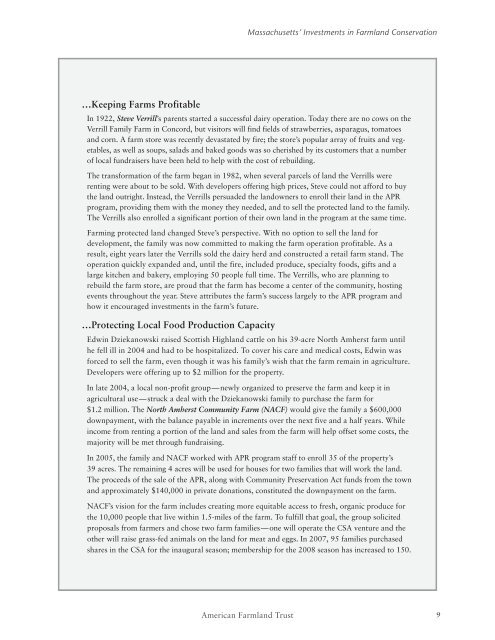
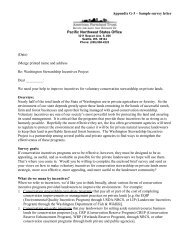

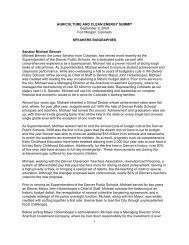
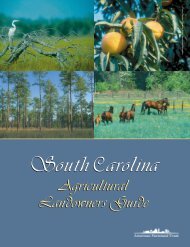
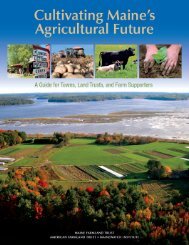
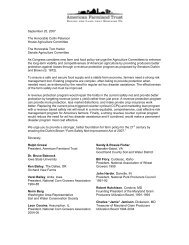
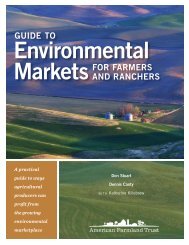
![Farmland by the Numbers [PDF] - American Farmland Trust](https://img.yumpu.com/31549391/1/190x245/farmland-by-the-numbers-pdf-american-farmland-trust.jpg?quality=85)
